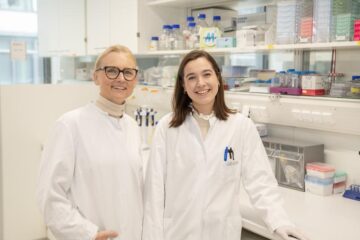Protein involved in ’mad cow’ disease

The scientific magazine Brain Research has recently published the results of research work by scientists from the University of Navarra. The work describes the presence and location of the cellular prion protein (PrPC) in the brain of the rat and characterises the neurones expressed therein, above all within the cerebral cortex of this rodent. The authors are José Luis Velayos and Francisco José Moleres, research scientists at the Department of Anatomy at the University of Navarra.
The PrPC is a normal physiological protein, especially present in the central nervous system, including that of the human, with functions that are little known as yet. Altered prionic proteins, pathogens, infectants, i.e. prions, are responsible for spongiform encephalopathies, amongst these being bovine spongiform encephalopathy (BSE or mad cow disease). In order to operate, prions require the presence of the PrPC. Thus, the importance of this investigation for the location of the PrPC in the central nervous system.
Knowing where in the central nervous system the prions operate
Locating the PrPC meant being able to identify which places in the central nervous system the prions operate. The findings enabled the research team to establish that the PrPC is a protein involved in the neuronal metabolism of calcium. Moreover, the existence of neurones without PrPC and surrounded by perineuronal nests breaks with the hypothesis, to date, that the disappearance of such nests – a special form of extracellular matrix – is a primary event in the course of spongiform encephalopathies; rather it is secondary event.
According to the researchers’ observations, the loss of these nests and consequent neuronal death are due to the damage produced after the appearance of the prions in the brain, where they act upon such perineuronal nests, amongst other structures.
According to the researchers’ comments, extrapolating these results from the rat to the human is valid, given that similar results had been obtained after carrying out the study on human brains. Moreover, this work and others carried out on the brains of the autochthonous Pyrenees breed of cow will help to explain the operating mechanisms of the prions in bovine spongiform encephalopathy.
This study, published in Brain Research, is an addition to the work of the Department of Pathological Histology and Anatomy at the University of Navarra regarding the manner in which prions enter the digestive tube of bovine animals, from which organ they enter the central nervous system, causing the mad cow disease or bovine spongiform encephalopathy.
Media Contact
More Information:
http://www.basqueresearch.comAll latest news from the category: Life Sciences and Chemistry
Articles and reports from the Life Sciences and chemistry area deal with applied and basic research into modern biology, chemistry and human medicine.
Valuable information can be found on a range of life sciences fields including bacteriology, biochemistry, bionics, bioinformatics, biophysics, biotechnology, genetics, geobotany, human biology, marine biology, microbiology, molecular biology, cellular biology, zoology, bioinorganic chemistry, microchemistry and environmental chemistry.
Newest articles

Researchers have found brown fat’s “off-switch
Researchers from the University of Southern Denmark, the Novo Nordisk Center for Adipocyte Signaling (SDU), the University of Bonn and the University Hospital Bonn (UKB) have found a protein that…

Combining robotics and ChatGPT
TUM professor uses ChatGPT for choreographies with flying robots. Prof. Angela Schoellig has proved that large language models can be used safely in robotics. ChatGPT develops choreographies for up to…

How the Immune System Learns from Harmless Particles
Our lungs are bombarded by all manner of different particles every single day. Whilst some are perfectly safe for us, others—known as pathogens—have the potential to make us ill. The…





















